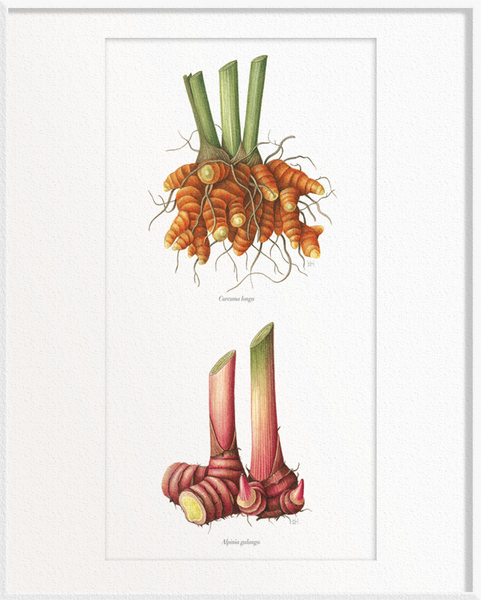Curcuma longa (Turmeric) x Alpinia galangal (Galangal)
Curcuma longa, common name turmeric, is a flowering plant of the ginger family Zingiberaceae. The plant is a perennial herbaceous plant, native to South and Southeast Asia that grows up to 1 metre tall. The greatest diversity of Curcuma species is in India and Thailand. The rhizome of Curcuma longa contains a pigment called curcumin, which gives the rhizome its yellow-orange colour. Curcumin is also a major compound and has many medicinal effects including antioxidant and anti-inflammatory. The rhizomes (underground horizontal stem) are used fresh or boiled in water and dried. They are then ground to make the intense yellow-orange powder used as a colouring and flavouring ingredient in many Asian cuisines. Turmeric powder has a bitter, peppery-like flavour and earthy, mustard-like smell. Curcuma longa has been widely cultivated for use in food and medicine, and as a dye since 600BC.
Alpinia galanga, a plant in the ginger family Zingiberaceae, is native to Southeast Asia. It is one of four plants known as ‘galangal’, which have common names lengkuas, greater galangal and blue ginger. It is a large, hardy perennial herbaceous plant that grows up to 3.5 metres tall. The plant grows from creeping rhizomes (underground horizontal stems) in clumps of stalks with long leaves that bear red fruit. The plant has been cultivated in tropical regions for a long time especially southern Asia and is sometimes harvested from the wild. The plant’s rhizome is the main component used in cookery. It has a sharp, spicy flavour popular in Southeast Asia, as well as India, and is used blended with other herbs and spices. It features in dishes such as laksa, curries and other dishes. The flowers and young shoots are eaten as a vegetable. Alpinia galangal is believed to have medicinal properties, and its seeds and leaves used in various treatments.
°°°°°
Specifications:
Paper
100% Cotton based, 320g, Acid-free, No optical brighteners.
Printed Area
A3, 297mm x 420mm – Approximately 207mm x 342mm
About the Collection
The Garden of Miss Joaquim Collection: Illustrated Botanical Prints
Agnes Joaquim was a Singapore-born Armenian who created what would become Singapore’s National Flower, the Vanda Miss Joaquim (scientific name: Papilionanthe Miss Joaquim), in 1893. The artificial hybrid was recognised by the first director of the Singapore Botanic Gardens, botanist Henry Ridley.
Agnes, the first woman in the world to create a hybrid orchid, was a well-known and successful horticulturist, garnering 70 horticultural awards from 1881 to 1899. The Garden of Miss Joaquim Collection of botanical prints commemorates her horticultural legacy and complements her story told in the book Agnes and Her Amazing Orchid.
In presenting Agnes’s award-winning plants in the illustrated collection, we looked at the newspaper records of the times, but they were of no use because they used common name descriptions of the plants, such as ‘rose’ and ‘durian’. So we turned to the Singapore Botanic Gardens and collaborated with a botanist to identify the likely species. To complete Agnes’s story, the collection includes two additional images: of Vanda Miss Joaquim’s parents, Papilionanthe teres (pod parent) and Papilionanthe hookeriana (pollen parent) — formerly in the genus Vanda — both of which may have been present in her award-winning floral bouquets or cut flowers. Waiwai Hove, a talented and respected botanical illustrator, was chosen to produce the prints.
*Disclaimer: Representative only based on subject. Not species definitive.
About the Illustrator
Born in Kuala Lumpur, Malaysia, Waiwai Hove developed a love for nature from a young age. Growing up surrounded by rich tropical flora and nurtured by her mother, a keen gardener, Waiwai has always held a special place for plants in her childhood memories. She holds a diploma in botanical illustration from the Society of Botanical Artists (UK), graduating in 2013 with a distinction and the highest marks in the history of the course.
She has since worked for the Singapore Botanic Gardens, where highlights include illustrations for ‘30 Heritage Trees’ and more recently ‘15 Gingers’. Four of Waiwai’s ginger paintings were subsequently used for a series of stamps issued by Singapore Post in 2018. Since 2019, Waiwai has begun working on the cover illustrations of 14 volumes of The Flora of Singapore, to be published over the next few years. Her works are in numerous private collections and can also be found in publications by the National Parks Board and in the Shirley Sherwood Collection in Kew Gardens, UK.




